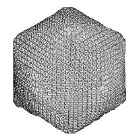Plant Pathology, Department of

James Van Etten Publications
Document Type
Article
Date of this Version
6-2010
Citation
JOURNAL OF VIROLOGY, Vol. 84, No. 17, Sept. 2010, p. 8829–8838. doi:10.1128/JVI.00770-10
Abstract
Nucleocytoplasmic large DNA viruses (NCLDVs) are characterized by large genomes that often encode proteins not commonly found in viruses. Two species in this group are Acanthocystis turfacea chlorella virus 1 (ATCV-1) (family Phycodnaviridae, genus Chlorovirus) and Acanthamoeba polyphaga mimivirus (family Mimiviridae), commonly known as mimivirus. ATCV-1 and other chlorovirus members encode enzymes involved in the synthesis and glycosylation of their structural proteins. In this study, we identified and characterized three enzymes responsible for the synthesis of the sugar L-rhamnose: two UDP-D-glucose 4,6-dehydratases (UGDs) encoded by ATCV-1 and mimivirus and a bifunctional UDP-4-keto-6-deoxy-D-glucose epimerase/reductase (UGER) from mimivirus. Phylogenetic analysis indicated that ATCV-1 probably acquired its UGD gene via a recent horizontal gene transfer (HGT) from a green algal host, while an earlier HGT event involving the complete pathway (UGD and UGER) probably occurred between a protozoan ancestor and mimivirus. While ATCV-1 lacks an epimerase/reductase gene, its Chlorella host may encode this enzyme. Both UGDs and UGER are expressed as late genes, which is consistent with their role in posttranslational modification of capsid proteins. The data in this study provide additional support for the hypothesis that chloroviruses, and maybe mimivirus, encode most, if not all, of the glycosylation machinery involved in the synthesis of specific glycan structures essential for virus replication and infection.


Comments
Copyright © 2010, American Society for Microbiology. All Rights Reserved. Used by permission.